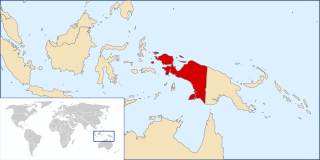The Amung people are a group of about 17,700 people living in the highlands of the Central Papua province of Indonesia. Most Amungme live in Mimika and Puncak, in valleys like Noema, Tsinga, Hoeya, Bella, Alama, Aroanop, and Wa. A related group live in Beoga Valley, Puncak and they are called Damal people.

The Asmat are an ethnic group of New Guinea, residing in the province of South Papua, Indonesia. The Asmat inhabit a region on the island's southwestern coast bordering the Arafura Sea, with lands totaling approximately 18,000 km2 (7,336 mi2) and consisting of mangrove, tidal swamp, freshwater swamp, and lowland rainforest.

The Trans-Fly – Bulaka RiverakaSouth-Central Papuan languages form a hypothetical family of Papuan languages. They include many of the languages west of the Fly River in southern Papua New Guinea into southern Indonesian West Papua, plus a pair of languages on the Bulaka River a hundred km further west.
The Kamoro language is an Asmat–Kamoro language spoken in New Guinea by approximately 8,000 people. Dialect diversity is notable, and Kamoro should perhaps not be considered a single language.
The Pauwasi languages are a likely family of Papuan languages, mostly in Indonesia. The subfamilies are at best only distantly related. The best described Pauwasi language is Karkar, across the border in Papua New Guinea. They are spoken around the headwaters of the Pauwasi River in the Indonesian-PNG border region.

New Guinea is the world's second-largest island, with an area of 785,753 km2 (303,381 sq mi). Located in Melanesia in the southwestern Pacific Ocean, the island is separated from Australia by the 150-kilometre wide Torres Strait, though both landmasses lie on the same continental shelf. Numerous smaller islands are located to the west and east.

The Yam languages, also known as the Morehead River languages, are a family of Papuan languages. They include many of the languages south and west of the Fly River in Papua New Guinea and Indonesian West Papua.
Ilaga is the name of a small town and a farming valley in Central Papua, Indonesia, with an elevation of 2,286 m (7,500 ft). It is also the capital of a government district (kecamatan) of the same name, and of the newly created (2008) Puncak Regency. Most of the residents of the area belong to the Western Dani tribe. It has a small airport and a tiny community of non-Papuan traders and government officials from other parts of Indonesia. A river of the same name runs through the valley, and is a tributary of the Ilorong. The valley lies about midway between the Enarotali and Baliem valleys.
Tsinga or Singa is a village in Indonesia located in Western New Guinea, in the kabupaten of Mimika Regency.
Jan Pouwer was a Dutch anthropologist with a thorough grounding in his profession in terms of fieldwork and theory. He studied Indology and Ethnology at Leiden University under the renowned Jan Petrus Benjamin de Josselin de Jong. He worked as a ‘government anthropologist’ and conducted extensive fieldwork in Netherlands New Guinea, 1951–62. He subsequently served as Professor of Anthropology at Amsterdam, Wellington (N.Z./Aotearoa) and Nijmegen Universities, 1962–87.
Murkim is a Papuan language of Western New Guinea, near its relatives Lepki and Kembra. Though spoken by fewer than 300 people, it is being learned by children. It is spoken in Murkim District, Pegunungan Bintang Regency, Papua Province, Indonesia.
The Wolani or Wodani are a people in the Indonesian Paniai regency (kabupaten) of the Central Papua Province in Western New Guinea. Numbering about 5000 in 1992, they are farmers who live in the central highlands northeast of Lake Paniai, along the Kemandoga and Mbiyandogo rivers. Many Wolani converted to Christianity but, like elsewhere in Indonesia, they retain their traditional religion. They speak Wolani, which is affiliated with the western branch of the Trans–New Guinea languages, similar to the nearby Ekari and Moni languages.

Kuala Kencana is a district in Mimika Regency, Central Papua, Indonesia. It is the purpose-built company town, managed by Indonesian mineral extraction company PT Freeport Indonesia. The new town was inaugurated by Indonesian President Suharto in 1995. The district covers an area of 860.74 km2 and had a population of 18,290 at the 2010 Census and 27,774 at the 2020 Census.

The southern variable pitohui is a species of pitohui in the family Oriolidae. It is found on New Guinea and neighbouring islands. Its natural habitat is subtropical or tropical moist lowland forests. It is also one of the few known poisonous birds, it carries the toxic compound homobatrachotoxins in its feathers and skin.
The Bensbach River is a river in southwestern Papua New Guinea. It is located just to the east of the Maro River in Merauke Regency, Indonesia, and just to the west of the Morehead River in Papua New Guinea.
Kepi is a town in Mappi Regency, South Papua, Indonesia. Following the formation of Mappi Regency in 2002, the town became its administrative seat.
The Grime River is a river in northern New Guinea, in Papua province, Indonesia.

Central Papua, officially the Central Papua Province is an Indonesian province located in the central region of Western New Guinea. It was formally established on 11 November 2022 from the former eight western regencies of the province of Papua. It covers an area of 61,072.92 km2 and had an officially estimated population of 1,430,951 in mid 2022. It is bordered by the Indonesian provinces of West Papua to the west, province of Papua to the north, and by Highland Papua and South Papua to the east. The designated administrative capital is located in Nabire Regency.








